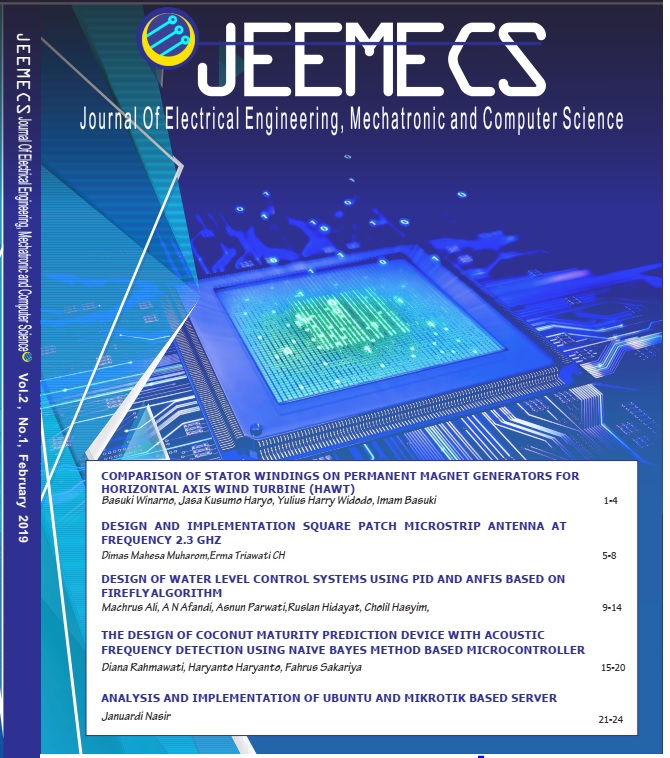DESIGN OF WATER LEVEL CONTROL SYSTEMS USING PID AND ANFIS BASED ON FIREFLY ALGORITHM
DOI:
https://doi.org/10.26905/jeemecs.v2i1.2804Keywords:
ANFIS, Firefly Algorithm, PID, Water Level.Abstract
At present, a controlling system of the fluid flow measurement is needed in industrial processes. Determination of the water quantity is also used to reduce the volume of water usage in the holding tank varies. The effort to overcome this problem has made using a system for regulating performances while a water flow based on the tank volume controlled using a PID system. This system uses a flow sensor to detect the water speed, an electric ball valve as an actuator. In principles, this tool is used to stabilize the output water speed per minute at a predetermined set point. This study is focused in five designed method comparison in associated with a water level without control, standard PID method, PID-Auto tuning method Matlab, PID-FA method, and ANFIS-PID-FA method. The results of the PID-FA training data are used as an input from ANFIS. From the simulation, it is also found that five control models have different performances while the ANFIS-PID-FA model is performed in the best control model. The ANFIS-PID-FA model has also the smallest overshot and undershot on the water level and output flow of 0.0021 pu, 0.0093 pu, 0.0072 pu, and 0.0096 pu
Downloads
References
X. Li, J. Li, and L. Shi, “Modeling and simulation of water level system,†in Proceedings of the IEEE International Conference on Automation and Logistics, ICAL 2008, 2008, pp. 2856–2859.
A. A. M. Eltaieb and Z. J. Min, “Automatic Water Level Control System,†Int. J. Sci. Res., vol. 4, no. 12, pp. 1505–1509, 2015.
B. Mondal, S. Rakshit, R. Sarkar, and N. Mandal, “Study of PID and FLC based water level control using ultrasonic level detector,†in 2016 International Conference on Computer, Electrical and Communication Engineering, ICCECE 2016, 2017.
Y.-T. Lin, Y.-C. Lin, and J.-Y. Han, “Automatic water-level detection using single-camera images with varied poses,†Measurement, vol. 127, pp. 167–174, Oct. 2018.
S. Omran, R. Broadwater, J. Hambrick, M. Dilek, C. Thomas, and F. Kreikebaum, “Load growth and power flow control with DSRs: Balanced vs unbalanced transmission networks,†Electr. Power Syst. Res., vol. 145, pp. 207–213, Apr. 2017.
E. Terzi, A. Cataldo, P. Lorusso, and R. Scattolini, “Modelling and predictive control of a recirculating cooling water system for an industrial plant,†J. Process Control, vol. 68, pp. 205–217, Aug. 2018.
C. M. Chew, M. K. Aroua, and M. A. Hussain, “Advanced process control for ultrafiltration membrane water treatment system,†J. Clean. Prod., vol. 179, pp. 63–80, Apr. 2018.
M. Ali, F. Hunaini, I. Robandi, and N. Sutantra, “Optimization of active steering control on vehicle with steer by wire system using Imperialist Competitive Algorithm (ICA),†in 2015 3rd International Conference on Information and Communication Technology (ICoICT), 2015, pp. 500–503.
H. Nurohmah, M. Ali, and M. R. B. Djalal, “Desain Frekuensi Kontrol pada Hibrid Wind-Diesel Dengan PID–Imperialist Competitive Algorithm (ICA),†J. Intake, vol. 6, no. 2, pp. 35–42, 2015.
N. Hamedazimi et al., “FireFly,†in Proceedings of the 2014 ACM conference on SIGCOMM - SIGCOMM ’14, 2014, pp. 319–330.
M. Dorigo, M. Birattari, and T. Stutzle, “Ant colony optimization,†IEEE Comput. Intell. Mag., vol. 1, no. 4, pp. 28–39, 2006.
A. N. Afandi et al., “Artificial salmon tracking algorithm: Preliminary designing approach for optimizing the integrated mixed energy composition,†MATEC Web Conf., vol. 204, p. 4002, 2018.
J. S. R. Jang, “ANFIS: Adaptive-Network-Based Fuzzy Inference System,†IEEE Trans. Syst. Man Cybern., vol. 23, no. 3, pp. 665–685, 1993.
M. F. Rachman, S. Muttaqin, and M. Ali, “Penggunaan Metode Imperialist Competitive Algorithm (ICA) untuk kontrol Frekuensi pada Wind-Turbine dan Hybrid Wind-Diesel,†in SAINTEK II-2017, UB, Malang, 2017, pp. 99–102.
M. Ali, “Kontrol Kecepatan Motor DC Menggunakan PID Kontroler Yang Ditunning Dengan Firefly Algorithm,†J. Intake, vol. 3, no. 2, pp. 1–10, 2012.
M. R. Djalal and M. Ali, “Particle Swarm Optimization Untuk Mengontrol Frekuensi Pada Hibrid Wind-Diesel,†J. Intake, vol. 7, no. 2, pp. 1–13, 2016.
D. H. Kusuma, M. Ali, and N. Sutantra, “The comparison of optimization for active steering control on vehicle using PID controller based on artificial intelligence techniques,†in Proceedings - 2016 International Seminar on Application of Technology for Information and Communication, ISEMANTIC 2016, 2017.
M. Ali, D. Ajiatmo, and M. Djalal, “Aplikasi Modified-Imperialist-Competitive-Algorithm (MICA) Untuk Merekonfigurasi Jaringan Radial,†JEEE-U, vol. 1, no. 2, pp. 17–20, 2017.
M. Ali, D. Ajiatmo, and M. R. Djalal, “Aplikasi Modified-Imperialist-Competitive-Algorithm (MICA) Untuk Merekonfigurasi Jaringan Radial Tenaga Listrik Pada Penyulang Mojoagung,†J. JEEEU, vol. 1, no. 2, pp. 17–21, 2017.
G. Zhang, B. Tian, W. Zhang, and X. Zhang, “Optimized robust control for industrial unstable process via the mirror-mapping method,†ISA Trans., Oct. 2018.
D. Hästbacka, T. Vepsäläinen, and S. Kuikka, “Model-driven development of industrial process control applications,†J. Syst. Softw., vol. 84, no. 7, pp. 1100–1113, Jul. 2011.
M. R. Assari, H. Basirat Tabrizi, and M. Savadkohy, “Numerical and experimental study of inlet-outlet locations effect in horizontal storage tank of solar water heater,†Sustain. Energy Technol. Assessments, vol. 25, pp. 181–190, Feb. 2018.
J. Oca and I. Masalo, “Flow pattern in aquaculture circular tanks: Influence of flow rate, water depth, and water inlet & outlet features,†Aquac. Eng., vol. 52, pp. 65–72, Jan. 2013.
W.-Y. Sun, “Hydraulic jump and Bernoulli equation in nonlinear shallow water model,†Dyn. Atmos. Ocean., vol. 82, pp. 37–53, Jun. 2018.
M. Alb, P. Alotto, C. Magele, W. Renhart, K. Preis, and B. Trapp, “Firefly Algorithm for Finding Optimal Shapes of Electromagnetic Devices,†IEEE Trans. Magn., vol. 52, no. 3, pp. 1–4, 2016.
Downloads
Published
Issue
Section
License
Our ethic statements are based on COPE’s Best Practice Guidelines for Journal Editors.
Publication decisions
The editor is responsible for deciding which of the articles submitted to the journal should be published.
The editor may be guided by the policies of the journal's editorial board and constrained by such legal requirements as shall then be in force regarding libel, copyright infringement and plagiarism. The editor may confer with other editors or reviewers in making this decision.
Fair play
An editor at any time evaluate manuscripts for their intellectual content without regard to race, gender, sexual orientation, religious belief, ethnic origin, citizenship, or political philosophy of the authors.
Confidentiality
The editor and any editorial staff must not disclose any information about a submitted manuscript to anyone other than the corresponding author, reviewers, potential reviewers, other editorial advisers, and the publisher, as appropriate.
Disclosure and conflicts of interest
Unpublished materials disclosed in a submitted manuscript must not be used in an editor's own research without the express written consent of the author.
Duties of Reviewers
Contribution to Editorial Decisions
Peer review assists the editor in making editorial decisions and through the editorial communications with the author may also assist the author in improving the paper.
Promptness
Any selected referee who feels unqualified to review the research reported in a manuscript or knows that its prompt review will be impossible should notify the editor and excuse himself from the review process.
Confidentiality
Any manuscripts received for review must be treated as confidential documents. They must not be shown to or discussed with others except as authorized by the editor.
Standards of Objectivity
Reviews should be conducted objectively. Personal criticism of the author is inappropriate. Referees should express their views clearly with supporting arguments.
Acknowledgement of Sources
Reviewers should identify relevant published work that has not been cited by the authors. Any statement that an observation, derivation, or argument had been previously reported should be accompanied by the relevant citation. A reviewer should also call to the editor's attention any substantial similarity or overlap between the manuscript under consideration and any other published paper of which they have personal knowledge.
Disclosure and Conflict of Interest
Privileged information or ideas obtained through peer review must be kept confidential and not used for personal advantage. Reviewers should not consider manuscripts in which they have conflicts of interest resulting from competitive, collaborative, or other relationships or connections with any of the authors, companies, or institutions connected to the papers.
Duties of Authors
Reporting standards
Authors of reports of original research should present an accurate account of the work performed as well as an objective discussion of its significance. Underlying data should be represented accurately in the paper. A paper should contain sufficient detail and references to permit others to replicate the work. Fraudulent or knowingly inaccurate statements constitute unethical behavior and are unacceptable.
Originality and Plagiarism
The authors should ensure that they have written entirely original works, and if the authors have used the work and/or words of others that this has been appropriately cited or quoted.
Multiple, Redundant or Concurrent Publication
An author should not in general publish manuscripts describing essentially the same research in more than one journal or primary publication. Submitting the same manuscript to more than one journal concurrently constitutes unethical publishing behaviour and is unacceptable.
Acknowledgement of Sources
Proper acknowledgment of the work of others must always be given. Authors should cite publications that have been influential in determining the nature of the reported work.
Authorship of the Paper
Authorship should be limited to those who have made a significant contribution to the conception, design, execution, or interpretation of the reported study. All those who have made significant contributions should be listed as co-authors. Where there are others who have participated in certain substantive aspects of the research project, they should be acknowledged or listed as contributors.
The corresponding author should ensure that all appropriate co-authors and no inappropriate co-authors are included on the paper, and that all co-authors have seen and approved the final version of the paper and have agreed to its submission for publication.
Disclosure and Conflicts of Interest
All authors should disclose in their manuscript any financial or other substantive conflict of interest that might be construed to influence the results or interpretation of their manuscript. All sources of financial support for the project should be disclosed.
Fundamental errors in published works
When an author discovers a significant error or inaccuracy in his/her own published work, it is the author’s obligation to promptly notify the journal editor or publisher and cooperate with the editor to retract or correct the paper.











